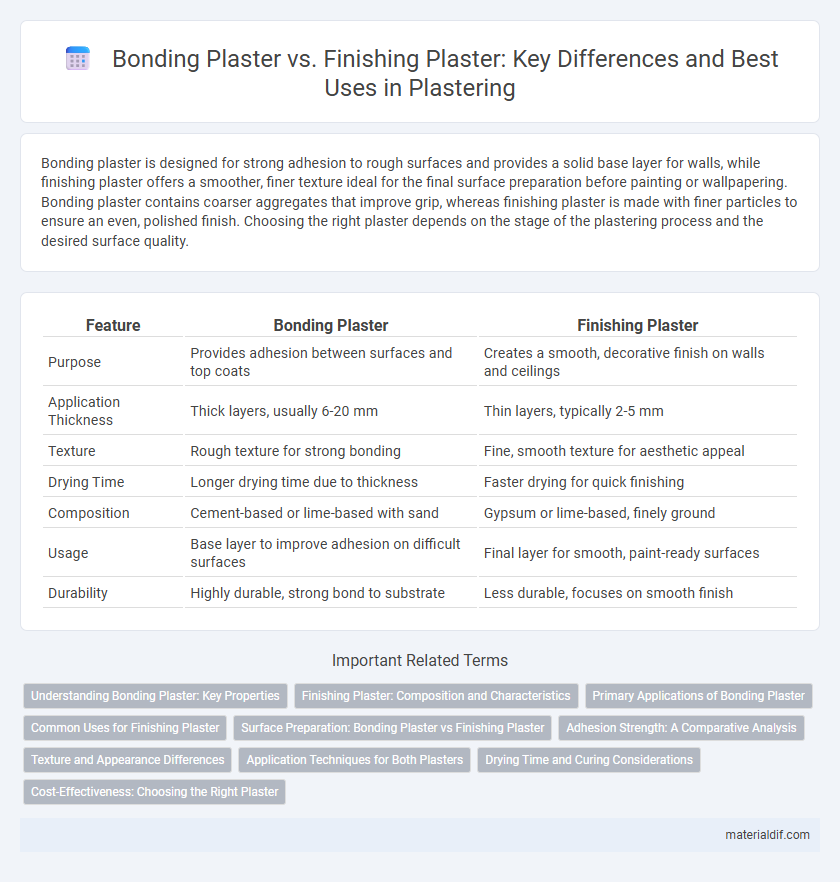Bonding plaster is designed for strong adhesion to rough surfaces and provides a solid base layer for walls, while finishing plaster offers a smoother, finer texture ideal for the final surface preparation before painting or wallpapering. Bonding plaster contains coarser aggregates that improve grip, whereas finishing plaster is made with finer particles to ensure an even, polished finish. Choosing the right plaster depends on the stage of the plastering process and the desired surface quality.
Table of Comparison
| Feature | Bonding Plaster | Finishing Plaster |
|---|---|---|
| Purpose | Provides adhesion between surfaces and top coats | Creates a smooth, decorative finish on walls and ceilings |
| Application Thickness | Thick layers, usually 6-20 mm | Thin layers, typically 2-5 mm |
| Texture | Rough texture for strong bonding | Fine, smooth texture for aesthetic appeal |
| Drying Time | Longer drying time due to thickness | Faster drying for quick finishing |
| Composition | Cement-based or lime-based with sand | Gypsum or lime-based, finely ground |
| Usage | Base layer to improve adhesion on difficult surfaces | Final layer for smooth, paint-ready surfaces |
| Durability | Highly durable, strong bond to substrate | Less durable, focuses on smooth finish |
Understanding Bonding Plaster: Key Properties
Bonding plaster features high adhesion properties, making it ideal for creating a strong base layer on smooth or non-absorbent surfaces. Its coarse texture and quick-setting formulation enhance the plaster's ability to grip underlying substrates securely. This type of plaster ensures optimal bonding strength, preventing delamination and providing a reliable foundation for subsequent finishing coats.
Finishing Plaster: Composition and Characteristics
Finishing plaster typically consists of fine, white gypsum or lime combined with additives like polymers and retarders to enhance workability and drying time. It possesses a smooth texture and excellent adhesion properties, making it ideal for creating a polished, decorative surface on walls and ceilings. Its fast-setting nature and ability to form a hard, durable finish distinguish finishing plaster from bonding plaster, which is primarily used for base coats.
Primary Applications of Bonding Plaster
Bonding plaster is primarily used to adhere new plaster layers to old, difficult surfaces such as concrete, brick, or asbestos, ensuring a strong foundational grip. It is ideal for creating a rough base that improves the adhesion of finishing plasters or decorative coatings. This type of plaster is essential in renovation projects where surface preparation is critical for long-lasting durability and crack resistance.
Common Uses for Finishing Plaster
Finishing plaster is primarily used for creating smooth, polished surfaces on interior walls and ceilings, preparing them for painting or wallpapering. It excels in providing a fine, even texture that conceals minor imperfections and enhances aesthetic appeal. Common applications include coating drywall, skim coating old plaster, and producing decorative moldings and intricate details.
Surface Preparation: Bonding Plaster vs Finishing Plaster
Bonding plaster requires a rough, clean surface free from dust, grease, or loose particles to ensure strong adhesion to the substrate. Finishing plaster demands a smoother, well-dampened surface to achieve an even, polished finish without cracks or flaking. Proper surface preparation tailored to each plaster type enhances durability and visual quality of the final coat.
Adhesion Strength: A Comparative Analysis
Bonding plaster exhibits superior adhesion strength compared to finishing plaster due to its coarser texture and higher cement content, which facilitates a stronger bond with rough masonry surfaces. Finishing plaster, formulated for smoothness and fine application, has lower adhesion to substrates but enhances surface finish quality and paint adherence. Understanding these differences aids in selecting the appropriate plaster type for foundational bonding versus decorative finishing tasks.
Texture and Appearance Differences
Bonding plaster offers a rough and coarse texture designed to adhere strongly to surfaces, providing a solid base for subsequent layers. Finishing plaster features a smooth, fine texture that creates a polished and visually appealing surface ideal for painting or wallpapering. The key difference lies in bonding plaster's enhanced grip and durability, while finishing plaster prioritizes aesthetic refinement and surface uniformity.
Application Techniques for Both Plasters
Bonding plaster requires a rougher surface and is typically applied with a hawk and trowel using firm pressure to ensure deep adherence to the substrate. Finishing plaster is applied more delicately, often with a steel trowel, to create a smooth, even surface suitable for painting or wallpapering. Proper moisture control during application is crucial for both plasters to prevent cracking and ensure optimal setting.
Drying Time and Curing Considerations
Bonding plaster typically dries faster than finishing plaster due to its coarser texture and higher absorption rate, making it ideal for initial wall preparation. Finishing plaster requires longer curing time to achieve a smooth, durable surface, as it contains finer particles and additives that enhance workability and finish quality. Proper drying and curing conditions for both types are essential to prevent cracking and ensure optimal adhesion and surface integrity.
Cost-Effectiveness: Choosing the Right Plaster
Bonding plaster is typically more cost-effective for initial wall preparation due to its strong adhesive properties and thicker consistency, making it ideal for rough surfaces and uneven walls. Finishing plaster, while slightly more expensive, provides a smooth, refined surface ideal for final decoration, reducing the need for additional sanding or filler, which can save time and labor costs. Selecting the right plaster balances upfront material expenses with long-term aesthetic and labor efficiency, ensuring budget-friendly and quality wall finishes.
Bonding plaster vs Finishing plaster Infographic

 materialdif.com
materialdif.com